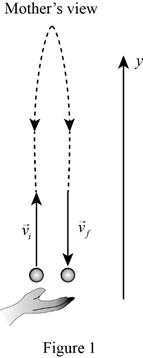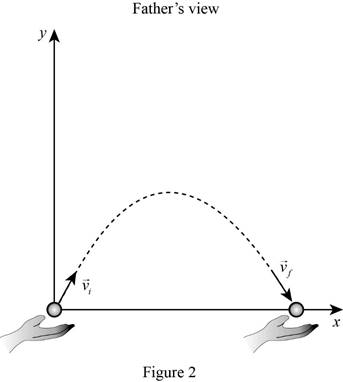
A mother pushes her son in a stroller at a constant speed of 1.52 m/s. The boy tosses a 56.7-g tennis ball straight up at 1.75 m/s and catches it. The boy’s father sits on a bench and watches.
a. According to the mother, what are the ball’s initial and final momenta?
b. According to the father, what are the ball’s initial and final momenta?
c. According to the mother, is the ball’s momentum ever zero? If so, when? If not, why not?
d. According to the father, is the ball’s momentum ever zero? If so, when? If not, why not?
(a)
The initial and final momentum of ball according to mother’s view.
Answer to Problem 4PQ
The initial momentum is
Explanation of Solution
Consider the figure showing the motion of ball on the basis of mother’s point of view.

According to mother’s point of view, the ball moves vertically upwards and falls vertically downwards with same speed. But initial momentum is in positive y direction and final momentum is in negative y direction.
Write the expression for initial momentum.
Here,
Write the expression for final momentum.
Here,
Conclusion:
Substitute,
Substitute,
Therefore, the initial momentum is
(b)
The initial and final momentum of ball according to father’s view.
Answer to Problem 4PQ
The initial momentum is
Explanation of Solution
Consider the figure showing the motion of ball on the basis of father’s point of view

The path of ball is now parabolic, horizontal velocity is same as those observed by mother, but vertical velocity is equal to the velocity of stroller.
Write the expression for initial momentum.
Here,
Write the expression for final momentum.
Here,
Conclusion:
Substitute,
Substitute,
Therefore, the initial momentum is
(c)
Whether the momentum of ball is zero ever according to mother.
Answer to Problem 4PQ
The momentum will be zero according to mother’s point of view.
Explanation of Solution
According to mother’s view the ball is in vertical motion. At maximum height the kinetic energy is completely converted to potential energy, and velocity of ball is zero, or ball is momentarily at rest.
Momentum is the product of mass and velocity, thus, if velocity is zero, momentum will be zero, at top of flight.
Conclusion:
Therefore, momentum will be zero, at maximum height according to mother’s view.
(d)
Whether the momentum of ball is zero ever according to father.
Answer to Problem 4PQ
The momentum is never become zero according to father’s view.
Explanation of Solution
The motion is parabolic according to father’s view, and has two components of velocity, horizontal and vertical. Even though vertical component become zero, at any point, the horizontal component remains same until the ball covers entire parabolic path.
Hence momentum will not be equal to zero.
Conclusion:
The total velocity is the sum of horizontal and vertical velocity, since horizontal velocity remains same as a nonzero value, momentum is never become zero.
Want to see more full solutions like this?
Chapter 10 Solutions
Webassign Printed Access Card For Katz's Physics For Scientists And Engineers: Foundations And Connections, 1st Edition, Single-term
- Please solve and answer this problem correctly please. Thank you!!arrow_forwarda) Use the node-voltage method to find v1, v2, and v3 in the circuit in Fig. P4.14. b) How much power does the 40 V voltage source deliver to the circuit? Figure P4.14 302 202 w w + + + 40 V V1 80 Ω 02 ΣΑΩ 28 A V3 + w w 102 202arrow_forwardPlease solve and answer this problem correctly please. Thank you!!arrow_forward
- You're on an interplanetary mission, in an orbit around the Sun. Suppose you make a maneuver that brings your perihelion in closer to the Sun but leaves your aphelion unchanged. Then you must have Question 2 options: sped up at perihelion sped up at aphelion slowed down at perihelion slowed down at aphelionarrow_forwardThe force of the quadriceps (Fq) and force of the patellar tendon (Fp) is identical (i.e., 1000 N each). In the figure below angle in blue is Θ and the in green is half Θ (i.e., Θ/2). A) Calculate the patellar reaction force (i.e., R resultant vector is the sum of the horizontal component of the quadriceps and patellar tendon force) at the following joint angles: you need to provide a diagram showing the vector and its components for each part. a1) Θ = 160 degrees, a2) Θ = 90 degrees. NOTE: USE ONLY TRIGNOMETRIC FUNCTIONS (SIN/TAN/COS, NO LAW OF COSINES, NO COMPLICATED ALGEBRAIC EQUATIONS OR ANYTHING ELSE, ETC. Question A has 2 parts!arrow_forwardThe force of the quadriceps (Fq) and force of the patellar tendon (Fp) is identical (i.e., 1000 N each). In the figure below angle in blue is Θ and the in green is half Θ (i.e., Θ/2). A) Calculate the patellar reaction force (i.e., R resultant vector is the sum of the horizontal component of the quadriceps and patellar tendon force) at the following joint angles: you need to provide a diagram showing the vector and its components for each part. a1) Θ = 160 degrees, a2) Θ = 90 degrees. NOTE: USE DO NOT USE LAW OF COSINES, NO COMPLICATED ALGEBRAIC EQUATIONS OR ANYTHING ELSE, ETC. Question A has 2 parts!arrow_forward
- No chatgpt pls will upvotearrow_forwardThe force of the quadriceps (Fq) and force of the patellar tendon (Fp) is identical (i.e., 1000 N each). In the figure below angle in blue is Θ and the in green is half Θ (i.e., Θ/2). A) Calculate the patellar reaction force (i.e., R resultant vector is the sum of the horizontal component of the quadriceps and patellar tendon force) at the following joint angles: you need to provide a diagram showing the vector and its components for each part. a1) Θ = 160 degrees, a2) Θ = 90 degrees. NOTE: USE ONLY TRIGNOMETRIC FUNCTIONS (SIN/TAN/COS, NO LAW OF COSINES, NO COMPLICATED ALGEBRAIC EQUATIONS OR ANYTHING ELSE, ETC. Question A has 2 parts!arrow_forwardNo chatgpt pls will upvotearrow_forward
- No chatgpt pls will upvotearrow_forwardSolve and answer the question correctly please. Thank you!!arrow_forward་ The position of a particle is described by r = (300e 0.5t) mm and 0 = (0.3t²) rad, where t is in seconds. Part A Determine the magnitude of the particle's velocity at the instant t = 1.5 s. Express your answer to three significant figures and include the appropriate units. v = Value Submit Request Answer Part B ? Units Determine the magnitude of the particle's acceleration at the instant t = 1.5 s. Express your answer to three significant figures and include the appropriate units. a = Value A ? Unitsarrow_forward
 Physics for Scientists and Engineers: Foundations...PhysicsISBN:9781133939146Author:Katz, Debora M.Publisher:Cengage Learning
Physics for Scientists and Engineers: Foundations...PhysicsISBN:9781133939146Author:Katz, Debora M.Publisher:Cengage Learning University Physics Volume 1PhysicsISBN:9781938168277Author:William Moebs, Samuel J. Ling, Jeff SannyPublisher:OpenStax - Rice University
University Physics Volume 1PhysicsISBN:9781938168277Author:William Moebs, Samuel J. Ling, Jeff SannyPublisher:OpenStax - Rice University Principles of Physics: A Calculus-Based TextPhysicsISBN:9781133104261Author:Raymond A. Serway, John W. JewettPublisher:Cengage Learning
Principles of Physics: A Calculus-Based TextPhysicsISBN:9781133104261Author:Raymond A. Serway, John W. JewettPublisher:Cengage Learning Physics for Scientists and Engineers with Modern ...PhysicsISBN:9781337553292Author:Raymond A. Serway, John W. JewettPublisher:Cengage Learning
Physics for Scientists and Engineers with Modern ...PhysicsISBN:9781337553292Author:Raymond A. Serway, John W. JewettPublisher:Cengage Learning College PhysicsPhysicsISBN:9781285737027Author:Raymond A. Serway, Chris VuillePublisher:Cengage Learning
College PhysicsPhysicsISBN:9781285737027Author:Raymond A. Serway, Chris VuillePublisher:Cengage Learning College PhysicsPhysicsISBN:9781938168000Author:Paul Peter Urone, Roger HinrichsPublisher:OpenStax College
College PhysicsPhysicsISBN:9781938168000Author:Paul Peter Urone, Roger HinrichsPublisher:OpenStax College





